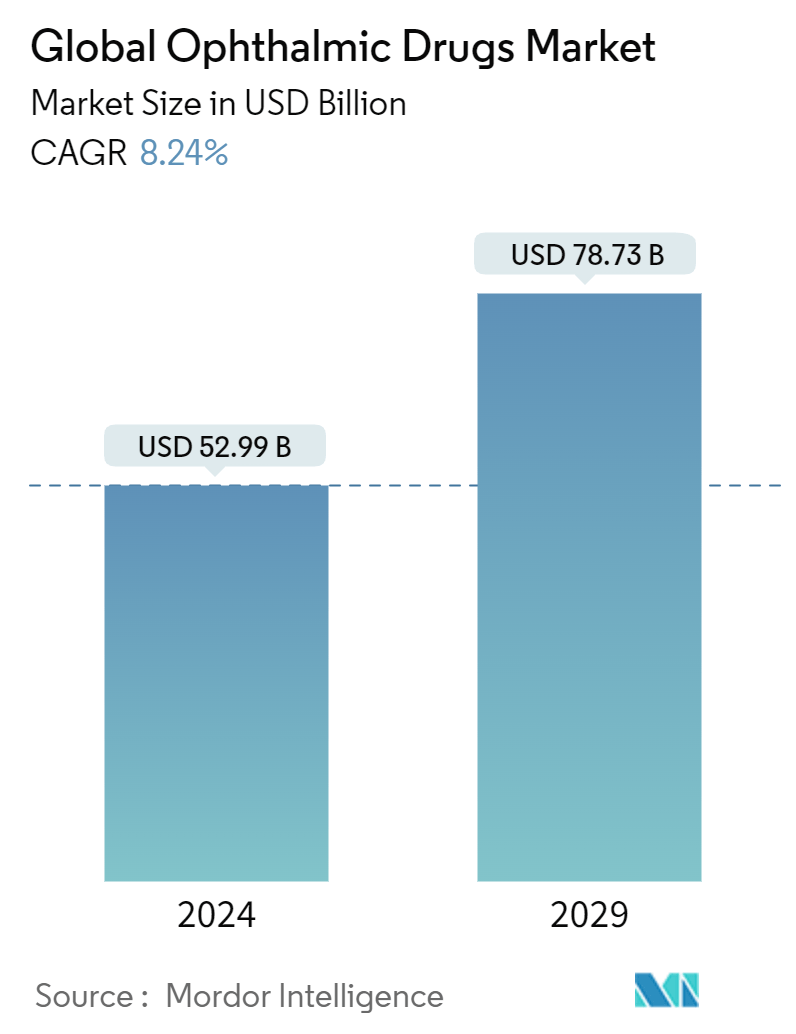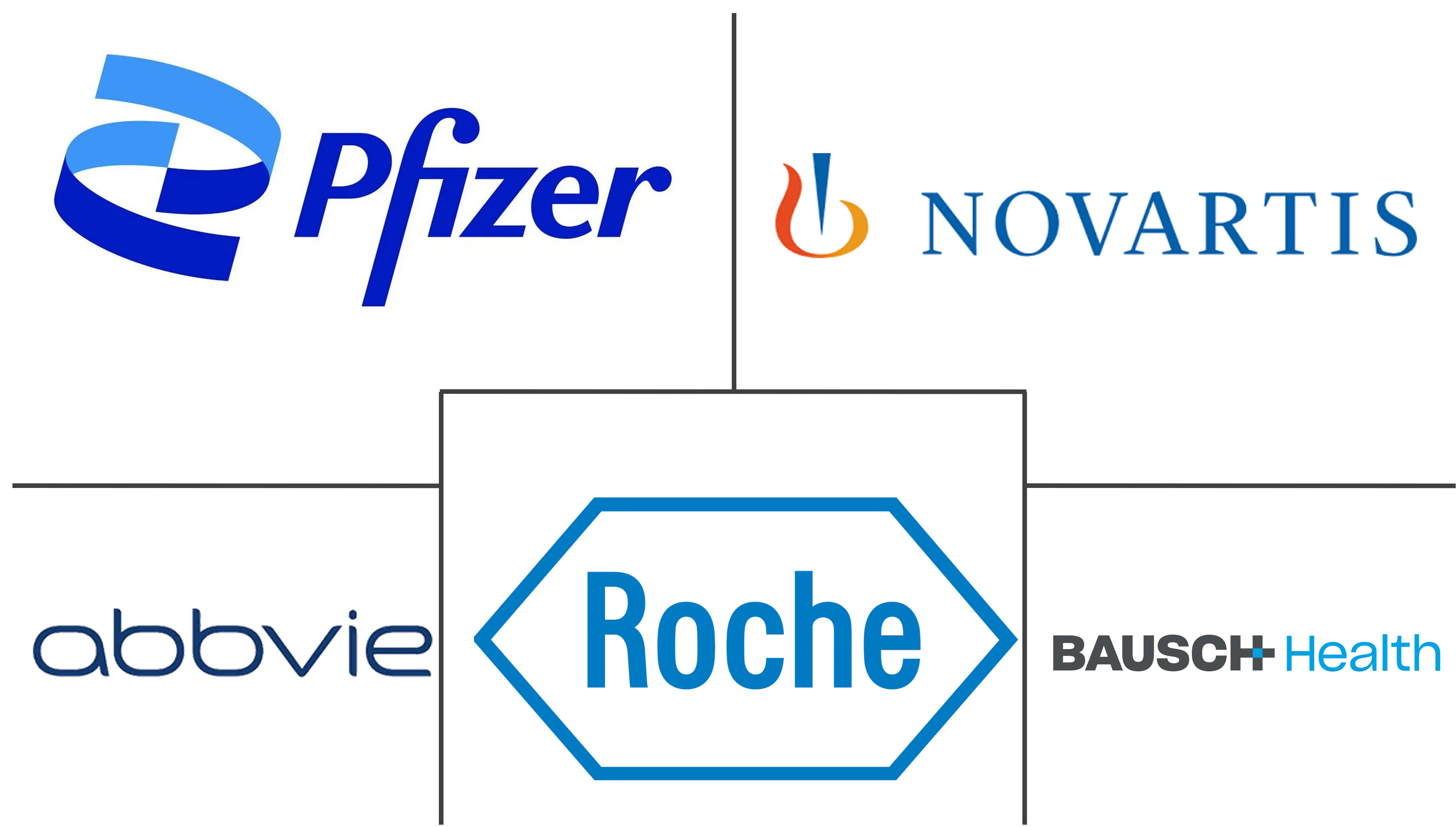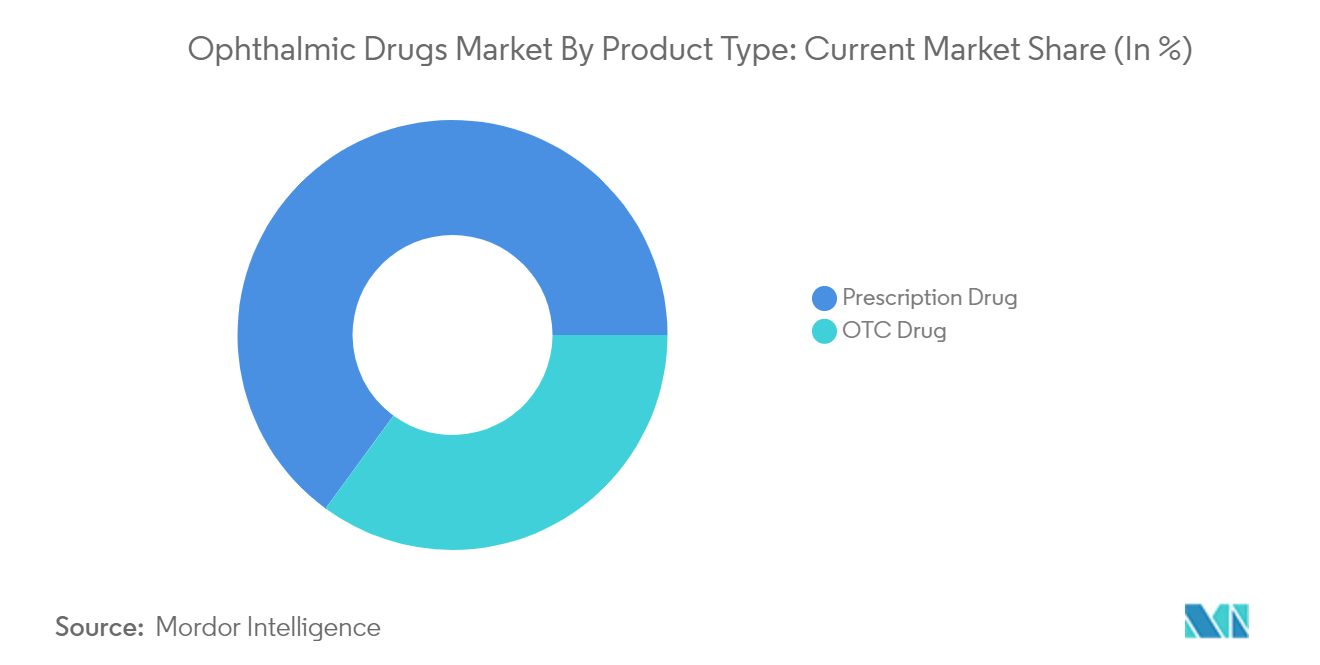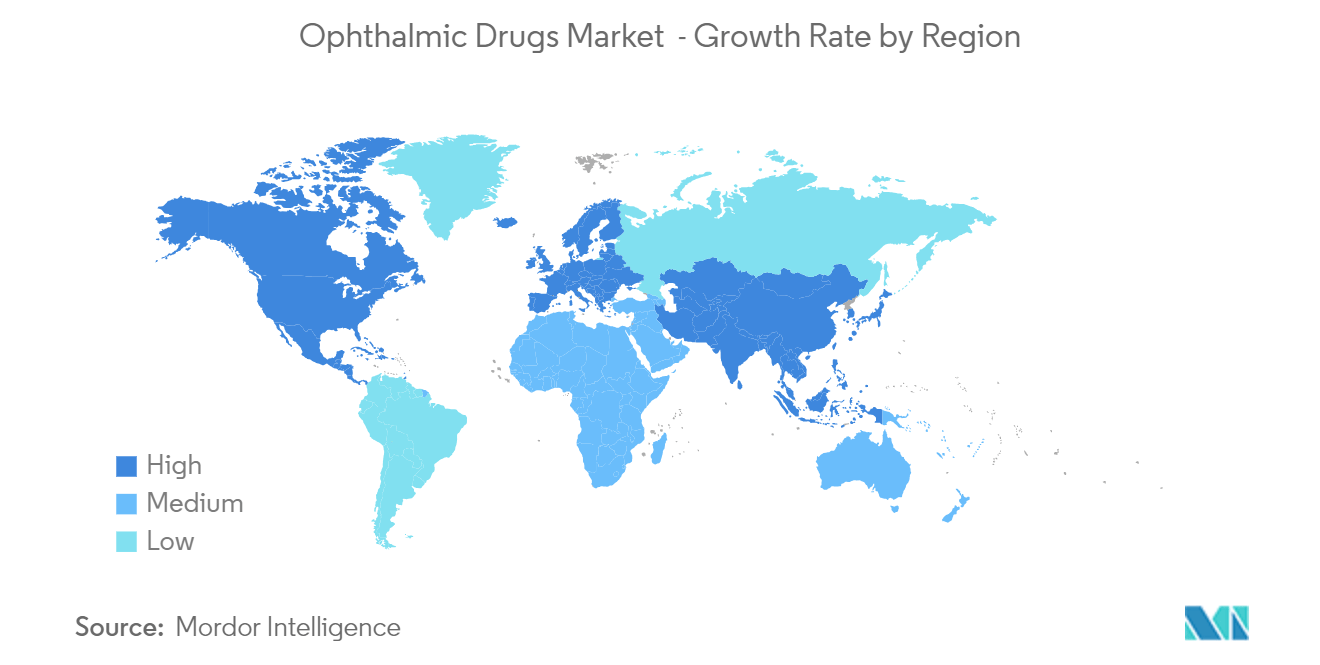Ophthalmic Drugs Market Size

| Study Period | 2019 - 2029 |
| Market Size (2024) | USD 52.99 Billion |
| Market Size (2029) | USD 78.73 Billion |
| CAGR (2024 - 2029) | 8.24 % |
| Fastest Growing Market | Asia-Pacific |
| Largest Market | North America |
Major Players
*Disclaimer: Major Players sorted in no particular order |
Ophthalmic Drugs Market Analysis
The Global Ophthalmic Drugs Market size is estimated at USD 52.99 billion in 2024, and is expected to reach USD 78.73 billion by 2029, at a CAGR of 8.24% during the forecast period (2024-2029).
The Global Ophthalmic Drugs Market is witnessing significant growth, underpinned by various factors driving both innovation and expansion in the industry. Key drivers include the increasing prevalence of eye-related disorders and advancements in drug development technologies, which are reshaping the market landscape.
Megatrends Shaping the Industry: The global rise in ocular conditions, an aging population, and advancements in drug formulation technologies are creating robust foundations for growth. These factors, along with specific industry drivers, are pushing the ophthalmic drugs market to new heights.
Increasing Incidence and Prevalence of Eye-related Disorders: The growing number of individuals with vision impairment is a major factor driving the ophthalmic drugs market. According to the World Health Organization, over 2.2 billion people globally suffer from vision-related issues, with at least 1 billion cases preventable. This population is impacted by conditions such as cataracts, refractive errors, glaucoma, and diabetic retinopathy. The high burden of these diseases underscores the urgent need for new and effective ophthalmic treatments, driving the market forward.
Rising Research and Development Pertaining to the Development of Novel Drugs: The ophthalmic drugs market is benefiting from increased R&D activity aimed at creating novel therapeutic solutions. The rise in clinical trials and drug approvals highlights this trend. In 2023, the FDA accepted a New Drug Application for CyclASol, a novel anti-inflammatory product for dry eye disease. Similarly, the European launch of a ranibizumab biosimilar by Xbrane Biopharma AB and STADA Arzneimittel AG showcases the surge in cost-effective treatment options. These innovative drugs are expanding the therapeutic landscape and boosting market growth.
Increasing Focus on Developing Combination Therapies: The emphasis on combination therapies within the ophthalmic drugs market is growing. These treatments offer superior therapeutic results for managing complex ocular diseases. For instance, Visus Therapeutics Inc. collaborated with Cella Therapeutics to develop a range of ophthalmic therapies targeting glaucoma and age-related macular degeneration. Such partnerships are fueling innovation in the field, accelerating market expansion by addressing unmet medical needs.
The Global Ophthalmic Drugs Market is on a steady growth trajectory, driven by these trends and developments. Future advancements in drug innovation, personalized treatments, and increased access to eye care will continue to shape the industry. As public awareness around eye health rises and early intervention becomes more critical, the market is poised for sustained growth.
Ophthalmic Drugs Market Trends
Prescription Drugs: Driving Force in Ophthalmic Treatments
Segment Overview: Prescription drugs play a pivotal role in ophthalmic treatments, addressing a wide range of conditions including glaucoma, dry eye, and retinal disorders. These drugs require medical oversight due to their potency and precision. Prescription ophthalmic medications account for approximately 65% of the market, illustrating their dominant role in eye care management.
Growth Drivers: The rising prevalence of chronic eye disorders, such as age-related macular degeneration and glaucoma, is boosting demand for prescription ophthalmic drugs. Advances in sustained-release technologies and combination therapies are further enhancing patient compliance and treatment outcomes. The global aging population is particularly susceptible to these disorders, which, along with increasing research and development efforts, are expected to bolster the growth of this segment.
Competitive Landscape: Leading companies in the prescription drug market are focusing on innovation to gain a competitive edge. The development of advanced drug delivery systems, such as intravitreal implants, is providing new solutions for complex eye conditions. Strategic collaborations and acquisitions are expanding product portfolios, while the rise of personalized medicine is driving the development of targeted therapies. However, potential disruptions, including gene therapies and regenerative medicine, may reshape the market.

North America: Leading the Charge in Ophthalmic Innovation
Regional Dynamics: North America continues to lead the global ophthalmic drugs market, exhibiting robust growth and innovation. With a highly developed healthcare infrastructure and strong market presence, North America is expected to expand at a compound annual growth rate (CAGR) of over 8% from 2024 to 2029. This growth is fueled by technological advancements, increasing healthcare investments, and rising awareness around eye health.
Market Catalysts: Several factors are driving North America's dominance in ophthalmic drugs. The region’s aging population and the prevalence of lifestyle-related ocular disorders contribute to a significant patient base. Favorable reimbursement policies and a supportive regulatory environment also encourage drug innovation and patient access to treatments. With strong funding for research and a focus on precision medicine, North America is expected to maintain its leadership in ophthalmic drug development.
Strategic Imperatives: To maintain their market position, companies are investing in research areas like gene therapy and regenerative medicine. Collaborations with biotech firms and academic institutions are essential for accelerating innovation. Additionally, digital health solutions, including telemedicine and artificial intelligence (AI), are increasingly integrated into eye care. Companies should also prepare for potential shifts in the competitive landscape, driven by tech entrants and value-based care models.

Ophthalmic Drugs Industry Overview
Market Dynamics: Global Players Dominate Consolidated Landscape
The Global Ophthalmic Drugs Market is largely controlled by major multinational pharmaceutical firms with broad product portfolios. Leading companies such as Novartis, Roche, and Regeneron hold substantial market shares due to their expansive R&D capabilities and strong distribution networks. The market is consolidated, with a few key players dominating a large portion of the total revenue. High entry barriers, complex regulatory frameworks, and the need for significant investment in R&D make it challenging for new entrants to compete with established players.
Market Leaders: Innovation and Pipeline Strength Drive Success
Leading companies like Novartis, Roche, and Regeneron have made significant strides in retinal disease treatments and other areas of ophthalmology. Novartis' innovations in retinal therapies and Regeneron's success with EYLEA in treating age-related macular degeneration exemplify this. These market leaders are also bolstered by their strong product pipelines, with several late-stage clinical candidates set to launch in the coming years. Their vast global presence and deep relationships with healthcare stakeholders solidify their competitive advantage.
Strategies for Future Success: Focus on Unmet Needs and Emerging Technologies
To capture future growth, companies must focus on unmet needs in ophthalmology, particularly in treating conditions like dry eye disease and diabetic retinopathy. Leveraging emerging technologies such as gene therapies and sustained-release drug delivery systems could provide a competitive edge. Companies developing long-acting intraocular implants for glaucoma, for instance, could capture significant market share from traditional treatments. Expansion into high-growth regions such as the Asia-Pacific will be critical, alongside partnerships with biotechnology firms and research institutions to foster innovation.
Ophthalmic Drugs Market Leaders
-
Bausch Health Companies Inc.
-
Novartis AG
-
Pfizer Inc.
-
Abbvie
-
F. Hoffmann-La Roche Ltd
*Disclaimer: Major Players sorted in no particular order

Ophthalmic Drugs Market News
- July 2024: Novaliq revealed that the Committee for Medicinal Products for Human Use (CHMP) of the European Medicines Agency issued a favorable opinion. They recommend granting marketing authorization in the European Union for Vevizye. This medication is designed to treat moderate to severe dry eye disease in adults, particularly when there's been no improvement with traditional tear substitutes.
- April 2024: Viatris Inc. launched its RYZUMVI (phentolamine ophthalmic solution) 0.75% in the United States to treat pharmacologically induced mydriasis produced by adrenergic agonists (e.g., phenylephrine) or parasympatholytic (e.g., tropicamide) agents.
Ophthalmic Drugs Market Report - Table of Contents
1. INTRODUCTION
- 1.1 Study Assumptions and Market Definition
- 1.2 Scope of the Study
2. RESEARCH METHODOLOGY
3. EXECUTIVE SUMMARY
4. MARKET DYNAMICS
- 4.1 Market Overview
-
4.2 Market Drivers
- 4.2.1 Increasing Incidence and Prevalence of Eye-related Disorders
- 4.2.2 Rising Research and Development Pertaining to the Development of Novel Drugs
- 4.2.3 Increasing Focus on Developing Combination Therapies
-
4.3 Market Restraints
- 4.3.1 Loss of Patent Protection for Popular Drugs
- 4.3.2 Lack of Health Insurance in the Developing Countries
-
4.4 Porter's Five Forces Analysis
- 4.4.1 Threat of New Entrants
- 4.4.2 Bargaining Power of Buyers/Consumers
- 4.4.3 Bargaining Power of Suppliers
- 4.4.4 Threat of Substitute Products
- 4.4.5 Intensity of Competitive Rivalry
5. MARKET SEGMENTATION (Market Size by Value- USD)
-
5.1 By Drug Class
- 5.1.1 Anti-glaucoma Drugs
- 5.1.2 Dry Eye Drugs
- 5.1.3 Ophthalmic Anti-allergy/Inflammatory
- 5.1.4 Retinal Drugs
- 5.1.5 Anti-infective Drugs
- 5.1.6 Other Drugs
-
5.2 By Product Type
- 5.2.1 OTC Drugs
- 5.2.2 Prescription Drugs
-
5.3 Geography
- 5.3.1 North America
- 5.3.1.1 United States
- 5.3.1.2 Canada
- 5.3.1.3 Mexico
- 5.3.2 Europe
- 5.3.2.1 Germany
- 5.3.2.2 United Kingdom
- 5.3.2.3 France
- 5.3.2.4 Italy
- 5.3.2.5 Spain
- 5.3.2.6 Rest of Europe
- 5.3.3 Asia-Pacific
- 5.3.3.1 China
- 5.3.3.2 Japan
- 5.3.3.3 India
- 5.3.3.4 Australia
- 5.3.3.5 South Korea
- 5.3.3.6 Rest of Asia-Pacific
- 5.3.4 Middle East and Africa
- 5.3.4.1 GCC
- 5.3.4.2 South Africa
- 5.3.4.3 Rest of Middle East and Africa
- 5.3.5 South America
- 5.3.5.1 Brazil
- 5.3.5.2 Argentina
- 5.3.5.3 Rest of South America
6. COMPETITIVE LANDSCAPE
-
6.1 Company Profiles
- 6.1.1 Aerie Pharmaceuticals Inc.
- 6.1.2 AbbVie (Allergan)
- 6.1.3 Bausch Health Companies Inc.
- 6.1.4 Bayer AG
- 6.1.5 F. Hoffmann-La Roche Ltd
- 6.1.6 Novartis AG
- 6.1.7 Viatris Inc.
- 6.1.8 Regeneron Pharmaceuticals Inc.
- 6.1.9 Santen Pharmaceutical Co. Ltd
- 6.1.10 Alcon
- 6.1.11 Sun Pharmaceutical Industries Ltd.
- 6.1.12 Teva Pharmaceutical Industries Ltd.
- *List Not Exhaustive
7. MARKET OPPORTUNITIES AND FUTURE TRENDS
** Subject To AvailablityOphthalmic Drugs Industry Segmentation
As per the scope of the report, ophthalmic drugs are used to treat various disorders associated with the eyes, such as glaucoma, cataracts, and diabetic retinopathy, to name a few. The ophthalmic drugs market is segmented by drug class, product type, and geography. By drug class, the market is segmented into anti-glaucoma drugs, dry eye drugs, ophthalmic anti-allergy/inflammatory, retinal drugs, anti-infective drugs, and other drugs. By product type, the market is segmented into OTC drugs and prescription drugs. By geography, the market is segmented into North America, Europe, Asia-Pacific, Middle East, and Africa, and South America. The market report also covers the estimated market sizes and trends for 17 countries across major global regions. The report offers the value (in USD) for the above segments.
| By Drug Class | Anti-glaucoma Drugs | |
| Dry Eye Drugs | ||
| Ophthalmic Anti-allergy/Inflammatory | ||
| Retinal Drugs | ||
| Anti-infective Drugs | ||
| Other Drugs | ||
| By Product Type | OTC Drugs | |
| Prescription Drugs | ||
| Geography | North America | United States |
| Canada | ||
| Mexico | ||
| Geography | Europe | Germany |
| United Kingdom | ||
| France | ||
| Italy | ||
| Spain | ||
| Rest of Europe | ||
| Geography | Asia-Pacific | China |
| Japan | ||
| India | ||
| Australia | ||
| South Korea | ||
| Rest of Asia-Pacific | ||
| Geography | Middle East and Africa | GCC |
| South Africa | ||
| Rest of Middle East and Africa | ||
| Geography | South America | Brazil |
| Argentina | ||
| Rest of South America |
Ophthalmic Drugs Market Research FAQs
How big is the Global Ophthalmic Drugs Market?
The Global Ophthalmic Drugs Market size is expected to reach USD 52.99 billion in 2024 and grow at a CAGR of 8.24% to reach USD 78.73 billion by 2029.
What is the current Global Ophthalmic Drugs Market size?
In 2024, the Global Ophthalmic Drugs Market size is expected to reach USD 52.99 billion.
Who are the key players in Global Ophthalmic Drugs Market?
Bausch Health Companies Inc., Novartis AG, Pfizer Inc., Abbvie and F. Hoffmann-La Roche Ltd are the major companies operating in the Global Ophthalmic Drugs Market.
Which is the fastest growing region in Global Ophthalmic Drugs Market?
Asia-Pacific is estimated to grow at the highest CAGR over the forecast period (2024-2029).
Which region has the biggest share in Global Ophthalmic Drugs Market?
In 2024, the North America accounts for the largest market share in Global Ophthalmic Drugs Market.
What years does this Global Ophthalmic Drugs Market cover, and what was the market size in 2023?
In 2023, the Global Ophthalmic Drugs Market size was estimated at USD 48.62 billion. The report covers the Global Ophthalmic Drugs Market historical market size for years: 2019, 2020, 2021, 2022 and 2023. The report also forecasts the Global Ophthalmic Drugs Market size for years: 2024, 2025, 2026, 2027, 2028 and 2029.
What are the emerging technologies shaping the future of the Ophthalmic Drug Industry?
The emerging technologies shaping the future of the Ophthalmic Drug Industry are a) Nanomedicine b) Sustained-release formulations c) Smart eye drops for controlled delivery
Ophthalmic Drugs Industry Report
The global ophthalmic drugs market, driven by an uptick in eye-related disorders and innovative drug development, is showcasing notable growth, spearheaded by ophthalmology pharmaceutical companies. With a focus on research and increased investments, the market is introducing novel therapeutics to meet eye care's unmet needs. North America's market prominence, backed by a high frequency of retinal diseases and government support, contrasts with the Asia Pacific's rapid growth, fueled by enhanced consumer awareness and a rising ophthalmic disorder burden. Innovations in drug delivery, like gene therapies and new pharmacologic agents, are pushing treatment efficacy forward, supported by collaborative efforts among key players to bring new products to market. The trend towards combination therapies and unique action mechanisms further diversifies ophthalmic care solutions, underlining the market's robust innovation and expansive growth trajectory. For detailed insights, Mordor Intelligence™ Industry Reports provide comprehensive analysis, including market share, size, revenue growth rate, and a forecast outlook, available as a free report PDF download.



